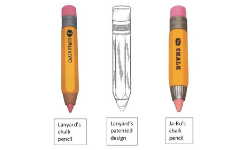
Lanyard Toys created a popular ‘chalk pencil’ that looked like a stubby pencil but that holds chalk. Lanyard protected the invention with a design patent. Remember that a design patent protects the appearance of a product, but not what it does or how it does it.*
Lanyard began selling its chalk pencils through a distributor to Toys-R-Us. Ja-Ru, Inc., a competitor, came up with its own design for a chalk pencil based on Lanyard’s chalk pencil, but with minor differences. Lanyard’s distributor stopped buying from Lanyard and instead re-sold Ja-ru’s chalk pencil to Toys-R-Us. Lanyard Toys promptly sued Ja-ru, the distributor and Toys-R-Us for infringement of the design patent.
The Federal Circuit considered whether the Ja-Ru product infringed Lanyard’s design patent.
The test to determine whether a product infringes a design patent is the ‘ordinary observer’ test. The court mentally places a product of Lanyard’s patented design next to the Ja-Ru’s copy and in front of an ‘ordinary observer;’ namely, the customer. If the customer reaches for the Ja-Ru copy thinking that he or she is reaching for the Lanyard original, then the Ja-Ru copy infringes the Lanyard design patent.
But there’s more to it than that. The only features of the Lanyard chalk pencil that count are the differences between the Lanyard patented design and the ‘prior art;’ namely, the familiar graphite pencil. Because graphite pencils (including really stubby graphite pencils) have been around for a long time, the design of a graphite pencil cannot be protected by a design patent. The Federal Circuit did not consider the pencil-like appearance of the Lanyard chalk pencil, but only the elements of the Lanyard chalk pencil that differ from the appearance of prior-art graphite pencils.
The Lanyard chalk pencil design differed from the prior art only in the shape of the pointed end and the trim around the eraser holder. When comparing the Lanyard patented design to the Ja-Ru chalk pencil, the pointed end of the Lanyard chalk pencil is smooth, while the end of the Ja-Ru chalk pencil is fluted; the Lanyard eraser holder features horizontal grooves while the Ja-Ru eraser holder has vertical and horizontal grooves. The court concluded that the ‘ordinary observer’ would not find the two designs confusingly similar; hence, Ja-Ru did not infringe Lanyard’s design patent.
The moral? A design patent for a clever product that makes something new look like something old will not protect much and will be easy for a competitor to avoid.
By the way, Lanyard, the patent owner, is based in Hong Kong. Ja-Ru, the copyist, is based in Florida. A decade or so ago, the Chinese government became a big believer in a strong patent system to move China from a nation of copyists to a nation of inventors. China has made numerous changes to make patents stronger in China. The U.S.? Not so much.
*A ‘utility’ patent can protect what a thing does and how it does it. Lanyard did not obtain a utility patent for its chalk pencil.
–Robert Yarbrough, Esq.

